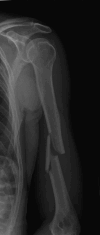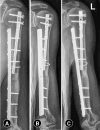Humeral intramedullary nail bending following trauma: a case report
- PMID: 39381670
- PMCID: PMC11309215
- DOI: 10.20408/jti.2022.0002
Humeral intramedullary nail bending following trauma: a case report
Abstract
The surgical approach for humeral implant failure can be challenging due to neurovascular anatomy and the possible necessity of osteosynthesis removal. We present a rare case of humeral nail bending after secondary trauma in a patient with preexistent nonunion of the humerus after intramedullary nailing. During revision surgery, the nail was sawed in half and the distal part was removed, followed by plate osteosynthesis with cable fixation to achieve absolute stability. The patient regained a full range of motion 1 year after surgery, and complete healing of the fracture was seen on imaging.
Keywords: Case reports; Humeral fractures; Intramedullary nail; Nail bending; Nonunion.
© 2023 The Korean Society of Traumatology.
Conflict of interest statement
Ethical statements Written informed consent for publication of the research details and clinical images was obtained from the patient. Conflicts of interest The authors have no conflicts of interest to declare.
Figures




References
-
- Court-Brown CM, Caesar B. Epidemiology of adult fractures: a review. Injury. 2006;37:691–7. - PubMed
-
- Hierholzer C, Sama D, Toro JB, Peterson M, Helfet DL. Plate fixation of ununited humeral shaft fractures: effect of type of bone graft on healing. J Bone Joint Surg Am. 2006;88:1442–7. - PubMed
-
- Healy WL, White GM, Mick CA, Brooker AF, Jr, Weiland AJ. Nonunion of the humeral shaft. Clin Orthop Relat Res. 1987;(219):206–13. - PubMed
Publication types
LinkOut - more resources
Full Text Sources

